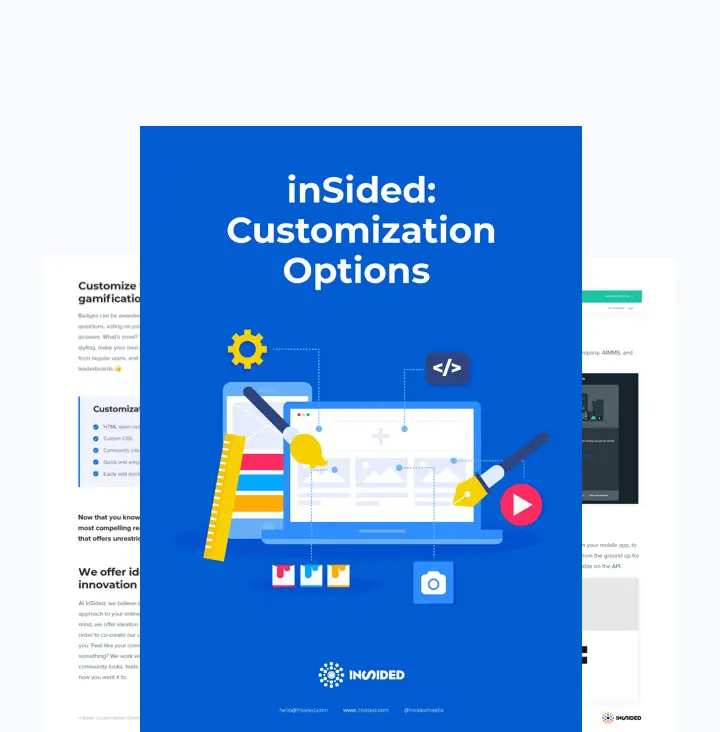Originally published on inSided.com on July 12, 2019.
The ability to customize a product is an important and sought-after request, especially in B2B software companies. As B2B SaaS offerings soar in popularity, so too does the desire for organizations to be able to put their own brand on their software and tailor its usage to effectively suit the needs of the end user. It’s an understandable request, right?
Of course, that said, customization itself is a wide-reaching term that can be determined very differently from company to company. For some, it may mean small configurations like changing fonts, for others it might mean having a team of your own developers coding integrations on the front end of a platform.
Stamping your own mark on a software product has its benefits, but it’s also vital to know why excessive customization isn’t always the best solution. Put this in the context of customizing your car. You might want new tires or seats, but change the engine and the chassis and you risk ending up with a completely different product that might not drive how you initially thought.
So, in regard to B2B software companies, what are the advantages and disadvantages of product customization?
Let’s start with the positives.
Advantages of unrestricted customization:
1. You can make everything brand specific
Making your company stand out from the crowd is one of the biggest challenges facing companies at the moment, not least in B2B software. This blog from ChartMogul neatly sets out the increasing importance B2B SaaS companies are putting on brand experience as the market becomes more and more crowded. One of the major advantages of having unrestricted customization capabilities is that you can fully tailor the product to match your own brand. Your developers can alter the front-end of the platform as much as they like (within reason) in order to ensure a consistent brand experience for the end user.
2. Build the product to specifically fit your use case
Another major worry for B2B software companies is that they can’t purchase an out-of-the-box product that precisely fits their use case. Having unfettered customization possibilities allows you to ensure that every update is specific to your own product use case, ultimately resulting in a better customer experience. This is particularly important if you have complex integrations you wish to implement.
Pro tip: Remember that often product configurations already on offer allow you to do exactly what you want, and more. It’s essential to assess if you really want, or need, extensive customization capabilities. So before you jump to assuming that you do, here are the downsides.
Disadvantages of unrestricted customization:
1. You will need developers
While having unrestricted customization capabilities can be a positive, they take time, money and resources to execute. Finding technical developers with the skills to implement your desired customizations is both costly and time consuming. At the same time, using your own development team would mean they are not 100% focused on improving your own product—not something a B2B SaaS company wants.
2. Rolling out new features can be a lengthy, buggy process
There is a lot of heavy lifting when it comes to rolling out new features and often (understandably) your own product takes priority. Leaving updates to a vendor ensures you won’t miss out on new features and gives time back to your own developers. Also, let’s face it, in most cases your vendors know their product better than you. It can be hugely beneficial to lean on their expertise and allow them to update what they think is best for you.
In addition, putting customizations in the hands of your own developers can leave you more susceptible to bugs. Most B2B SaaS providers A/B test their own feature updates to ensure they are as bug-free as possible. Allowing your platform provider to remove glitches before rolling-out updates not only saves you time and resources, it ensures a much better customer experience for your end users and means less hassle for your own team. A win-win all round.
So what’s the main takeaway here?
Actually, experience (10 years in the software space to be precise) has taught us that unrestricted customization capabilities are often requested, yet rarely used. We find they are a ‘nice-to-have’ for development teams but in reality, customization falls by the wayside and you end up with a product that is lagging behind.
Our advice? Don’t assume that you need maximum customization of a SaaS product. Leaving the heavy lifting to the creators of the product itself is often the way forward.
Please feel free to download our free whitepaper, inSided: Customization Options, to find out exactly what is customizable on our platform, and why.

Download inSided: Customization Options
Find our exactly what can be customized on the inSided platform and how that benefits you.
Learn More
Looking create a single destination for your customers to connect, share best practices, provide feedback, and build a stronger relationship with your product? Schedule a demo to learn more.


